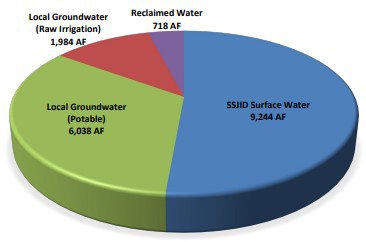Manteca uses 40 percent less groundwater today than it did in 2014.
And that is despite currently having 90,000 residents – 16,700 more than nine years ago.
That means the city is ahead of the curve when it comes to fully implementing groundwater substantiality as the state is requiring by 2042 despite being part of one of the most critically over-drafted water basins in California.
A consultant giving a quick overview of an exhaustive water masterplan presented to the City Council on Tuesday made that significant notation.
While it doesn’t mean Manteca won’t face water challenges as hydrology changes, growth, plus state water policy evolves, the city will generally be in a much better position than almost all other jurisdictions in the Northern San Joaquin Valley.
And that can be attributed to a decision that led to treated surface water captured from the Stanislaus River watershed and treated by the South San Joaquin Irrigation District to start flowing to Manteca in 2005.
Manteca was on 100 percent groundwater before that.
Originally, the intent was to rely on the SSJID surface water for 53 percent of Manteca’s water supply.
Today it accounts for 60 percent.
The operational strategy was, for all practical purposes, to cease ground pumping during the wet months by using almost exclusively surface water and then using ground water to augment supplies during the spring, summer and early fall.
The strategy was then spurred by a desire to reduce PG&E costs to operate what are now 15 potable water wells and two back up wells to reduce coasts.
But now it blends well with the mandated Sustainable Groundwater Management Act mandate adopted in 2012.
In a nutshell, a water basin by 2042 can’t take more water from the ground than is replenished during any given year.
Tracy and Lathrop also receive treated surface water from the SSJID plant.
Those cities, however, have different situations than Manteca.
Lathrop needs to use well water year round. It also has to deal with saltwater intrusion issues with the underground aquifer.
While salinity is an issue everywhere in the Central Valley, it is less in Manteca given the city is farther from the Delta and local geological considerations.
Tracy has three sources of water — ground, SSJID and the Central Valley Water Project — due to its aquifer not being able to keep pace with growth demands.
Making sure water flows from the tap and toilets flush is part of the basic service scenario residents expect from their municipal government.
That was an observation made by Councilman Charlie Halford after elected officials received updated wastewater and water master plans.
And, as Councilman Jose Nuno added, the city is making sure the critical work is being done without most even being aware of it.
The fact previous city leadership placed a high priority on the long-range sewer and water needs is why Manteca is in the position it is in today.
The current council is building on that foundation.
That also holds true for stormwater removal and flood protection.
Manteca’s early decision in the 1980s to embrace storm drainage basins throughout the city as part of neighborhood parks and other areas why Manteca has avoided — for the most part – localized street flooding that is the Achilles Heel of communities located on flat land.
The masterplan — in using 2020 as the base year — noted annual water consumption is 16,976 acre feet.
Of that:
*9,244 acre feet is SSJID surface water.
*6,038 acre feet is portable groundwater.
*1,984 acre feet is non-portable groundwater.
*718 acre feet is reclaimed water.
Non-portable groundwater didn’t enter into the equation until 2008.
That is when the city — seeking to keep water costs to ratepayers down as well as to improve water pressure — installed its first shallow well along the Tidewater Bikeway for the purpose of parkland irrigation.
Today, there are 31 such wells that tap into the high water table that is as high as 15 feet below the surface in the western part of Manteca and 25 feet below the surface in the east.
Portable water used for drinking is taken from wells that go down 190 to 400 feet.
That water is treated at the well head.
By not using portable water, the water being used to irrigate much of the park acreage in Manteca avoids using expensive treated drinking water that also needs to be pumped from deeper wells.
Outdoor irrigation is 50 percent of the overwater use in Manteca.
City parks are irrigated during the most efficient time to do so roughly from 10 p.m. to 8 a.m. — that includes one of the two peak water use times when people as people are waking up and taking showers and such.
The city currently is allocated 11,500 acre feet from the SSJID treatment plant in a given year.
When the second phase is up and running — projected to happen by 2040, if not sooner — Manteca’s annual surface water access will come to 18,500 acre feet.
At the same time, 5,193 acre feet of recycled water from the city’s wastewater treatment plant is expected to be used to help take pressure off the critical Eastern San Joaquin Groundwater Basin by being applied to agricultural crops.
To contact Dennis Wyatt, email dwyatt@mantecabulletin.com





